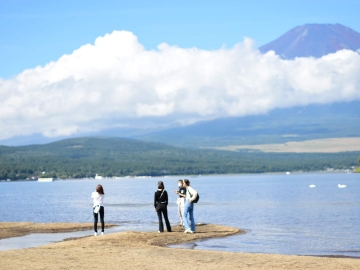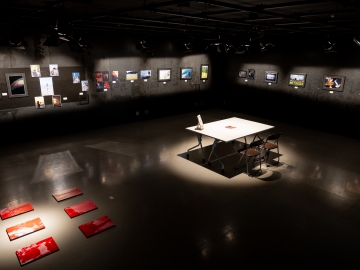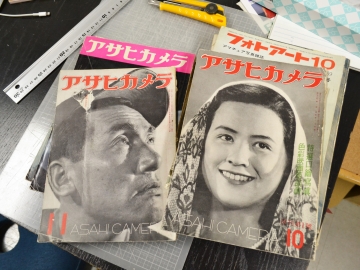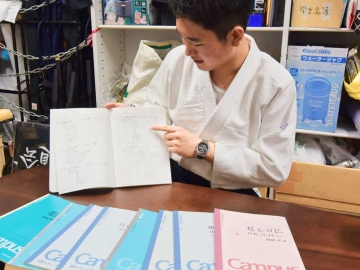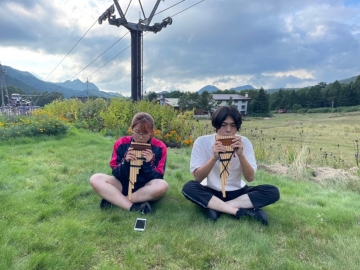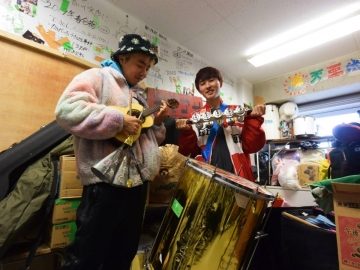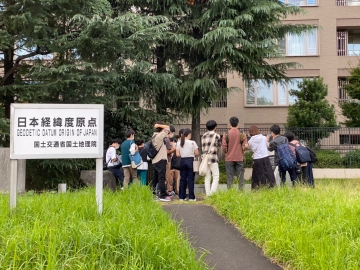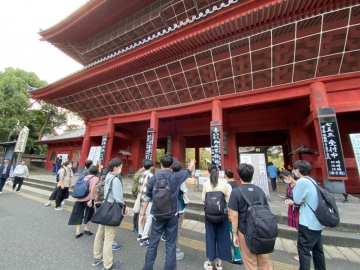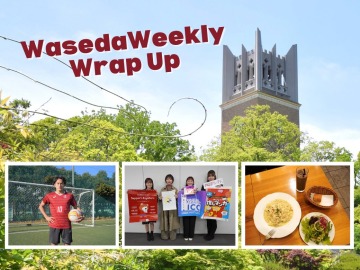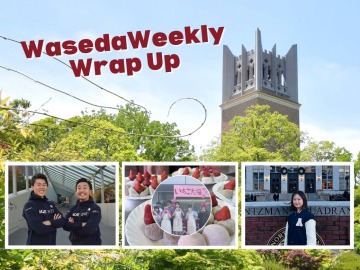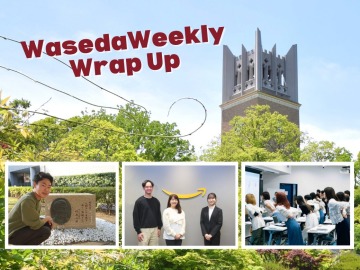There are about 500 official clubs at Waseda University. They cover a wide range of types, including sports, academia, art, international exchange, volunteering, and music, and were founded at various times. Waseda Weekly reporters Takumi Hasegawa and Hiroto Yamamoto have gone undercover in the clubrooms of the Student Center (Building 30) on the Toyama Campus, which is usually open only to club members. We visited the clubrooms of five clubs and asked about their activities and how they used their clubrooms. Furthermore, we asked each club to show us their treasures! Regardless of school year, everyone is welcome to join these clubs at any time. Which club’s “door” would you knock on?

On the 2nd floor of Building 30 on the Toyama Campus, in front of the Student Center’s clubroom guide. The Waseda Weekly reporters in charge of the interviews, from left to right: Hasegawa-san and Yamamoto-san
INDEX
▼1.Waseda Photo Society
▼2.Waseda University Aikidokai
▼3.Waseda Karuta
▼4.Waseda University Latin America Association
▼5.Waseda Society of Geography
1. Waseda Photo Society
Serious-minded photography club. Film development is also possible in the darkroom
Tomoyuki Harada, Secretary-General, 3rd year in the School of Advanced Science and Engineering
Keito Masuoka, Deputy Secretary-General, 3rd year in the School of Humanities and Social Sciences
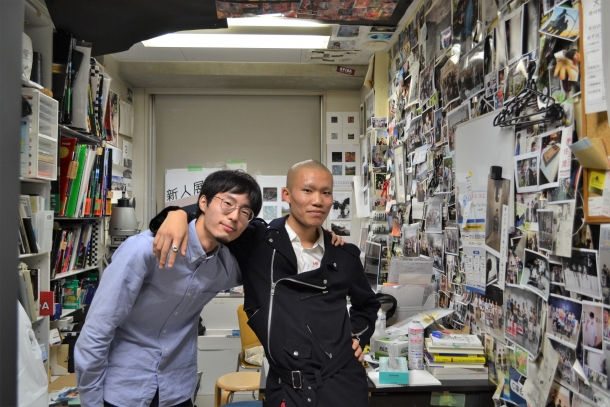
Harada-san, Secretary-General (left) and Masuoka-san, Deputy Secretary-General (right)
――Please tell us about your activities and appeal of the club.
Harada: On weekdays, we hold workshops after class, where we go out to shoot around the university and study photography in conference rooms at the Student Center. There are at least 3–4 participants in each session and about 15 at most. On holidays, we also hold little photo outings, and recently we went to Kamakura, Nagatoro, and Mt. Takao. About 20 members participate on these trips, each taking pictures and appreciating those taken by others. Moreover, we hold photo exhibitions eight times a year, both inside and outside the university. We take a lot of photos on a daily basis, so we don’t have to worry about not having enough for the exhibitions.
I suppose that most club members don’t simply think of photography as “records” or “tools to connect with people” but rather want to shed light on photography itself and think about technical and artistic aspects. It’s very easy to take pictures, but it’s actually a deep world. Beginners are also welcome, so please take the chance to step into this world.
Left: Training camps are held 1–2 times a year. Training camp at Lake Yamanaka (Yamanashi Prefecture) in September 2022
Right: The venue for the “Newcomers Exhibition” held at the Student Center in September 2021. The genres of their works are diverse, from landscapes, and portraits to snapshots. Some members take photos of cars and airplanes.
――How do you use the clubroom?

A darkroom dedicated to the photography club used for film development. Harada-san is holding a reel for winding film.
Harada: While the clubroom is a workplace in part, it is also a place for people to hang out. In addition to machinery, such as computers, printers, and scanners, there are also tools, such as cutters and cutter mats for cutting printed photos, and everyone uses their favorite camera, such as their own digital camera, DSLR camera, or film camera. About half of the club members use film cameras. Moreover, there is a darkroom dedicated to the photography club in front of the clubroom, where it is possible to develop and print film.
――Please show us your clubroom “treasures.”
Harada: There are photos pasted all over the wall. For more than 20 years since the Student Center moved to its current location, photos of activities have been pasted on top of each other. It is a treasure of the Waseda Photo Society that keeps growing while being passed down from generation to generation.
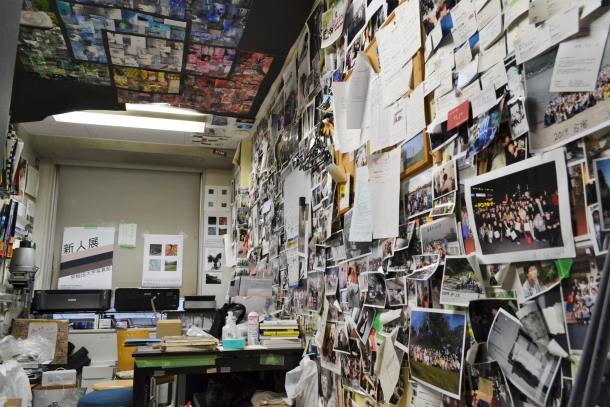
New photos are overlaid on top of old ones, making them look like geological formations.
Masuoka: This first reissue of Asahi Camera, published in October 1949, is also valuable. This is the first issue that was republished after a hiatus during the war. In addition to the contents of the magazine, it is also interesting to get a glimpse of what it was like at that time, such as advertisements and the market price of used cameras.
Left: Asahi Camera (Asahi Shimbun Publishing Inc., then Asahi Shimbun. Suspended as of 2022). There are several other valuable magazines in the clubroom
Right: The members of the Waseda Photo Society who welcomed us. They are holding their favorite books from the many photo books on the shelf.
【information】
◆Club name: Waseda Photo Society
◆Category: Student Club
◆Club established: 1902
◆Genre: Photography
◆Dates and times: Weekdays 18:00–20:00, 2–3 workshops per week (photography workshops and seminars), 1–2 photo sessions per month during holidays
◆Number of members: 92
◆Locations: Student Center clubroom (including dark room), meeting space/conference rooms at the Student Center, suburban parks, etc.
◆Twitter: @wphoto101
◆Instagram: @wpsgramofficial
2. Waseda University Aikidokai
A martial art without a winner or a loser. Recommended for those who are looking to start a new sport as they enter Waseda University
Takumi Matsubara, Captain, 3rd year in the School of Education
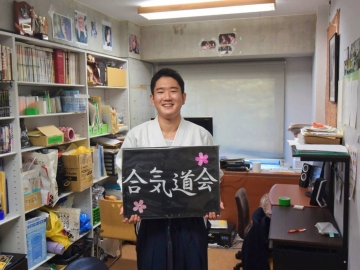
Matsubara in aikido uniform(道着)
――Please tell us about your activities and appeal of the club.
Matsubara: The members of the Waseda University Aikidokai train to acquire black belt(段), with the long-term goal of training the mind and the body. The club holds trainings(稽古) six days a week (Monday to Saturday), renting the Aikikai Headquarter Dojo(合気会本部道場) in Shinjuku-Ku and a dojo near the university. Members can choose how often they want to participate depending on their schedule or lifestyle, including responsibilities with part-time jobs and classes. The members from the Faculty of Science and Engineering, who are known for having lots of schoolwork, can testify to how flexible the activities and training at the Aikidokai are.
Aikido is a martial art without a winner or loser. It uses the structure of the human body and shifts of the center of gravity to perform techniques(技) on the opponent. Depending on your standing position and body build, you can easily defend attacks from your opponent or conversely not be able to defend attacks from your opponent if only one aspect, such as the center of gravity or posture, is altered. Furthermore, the same technique is performed differently by different individuals. Many people are drawn to aikido because it is challenging and there is no single correct answer; one can continue to explore the same technique due to its depth and complexity. Furthermore, since aikido does not require strength, it enables smaller people to fend off attacks from people of large physique.

Training. They are instructed by the teacher (center of the photo) who is an alumnus of the Waseda University Aikidokai.
More than 90% of the members of Waseda University Aikidokai have had no prior experience. I myself started at university because I had always admired martial arts and you can start easily without much experience. Teachers and seniors will teach you carefully from scratch, so it is recommended for those who want to start a new sport from university!
――How do you use the clubroom?
Matsubara: In addition to being used as a storage area for practice equipment, it is also a place for members to gather before training. In the clubroom, there are old manga and video game consoles donated by seniors, and members can deepen friendships among members through games between classes. It is also appealing that, while there is a serious focus in training, the clubroom is usually for fun and excitement.
――Please show us your clubroom “treasures.”
Matsubara: The treasure of the Waseda University Aikidokai is a practice diary(稽古日誌) that has been kept for more than 10 years. In the practice diary, first-year members write down the content of the practice they did that day, the type of technique, and so on. The notebook allows those who could not attend the training to learn about the contents, covered in that training, and it provides a basis for the seniors to make training menu for future training. The practice diary is an indispensable thing for the Aikidokai!
Left: The practice diary with a history of more than 10 years.
Right: In 2021, the club won the Federation Award at the “All Japan Student Aikido Demonstration” held at the Nippon Budokan (pictured is Igarashi, captain of 2021).
【Infomation】
◆Club name: Waseda University Aikidokai
◆Category: Student Club
◆Club established: 1960
◆Genre: Martial arts
◆Dates and times: Monday 15:00–16:45 Aikido Headquarters Dojo;
Tuesday 18:30–21:30 Edogawabashi Gymnasium;
Wednesday and Friday 16:00–17:30 Aikido Headquarters Dojo;
Thursday 16:45–18:15 Aikido Headquarters Dojo;
Saturday 12:20–15:20 Shinjuku Cosmic Center or Edogawabashi Gymnasium
◆Number of members: 39
◆Website: https://aikidoshinkan.wixsite.com/waseda-aikidokai
◆Twitter: @WasedaAikidokai
3. Waseda Karuta
The exhilaration of snatching cards is amazing. Of the 100 poems, 43 are love poems. One part of the appeal is the fun of familiarizing yourself with the classics.
Chisumi Koitabashi, Secretary-General, 2nd year in the School of Humanities and Social Sciences
Kasei Tamiya, 2nd year in the School of Creative Science and Engineering
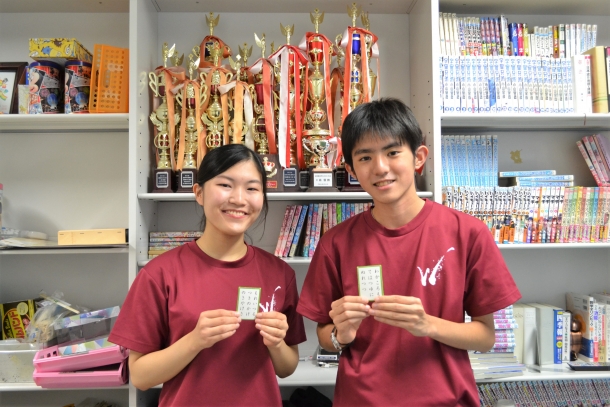
They have their favorite card(from the Ogura Hyakunin Isshu) in hand.
――Please tell us about the activities of the club.
Koitabashi: Four times a week, we practice competitive karuta in the Japanese-style room of the Student Center and at facilities outside the university; 20–25 players participate in each practice session, and we play three matches of 1 to 1.5 hours.
Tamiya: Karuta is a competition that uses the “Ogura Hyakunin Isshu” in which players are read the first half of a poem and compete to take the corresponding card with the second half. You start with 25 cards each on your own side and that of your opponent, and whoever gets rid of their own cards first wins.
(*) Reference: First, you and your opponent randomly select 25 cards from 100 cards and arrange them on your own side. Then, you listen to the first part of the poem read by the reader and take the card before the other person. If you take the opponent’s card, you send any one of your own cards to the opponent’s side. In the end, whoever runs out of their own cards first wins. [From the All Japan Karuta Association]
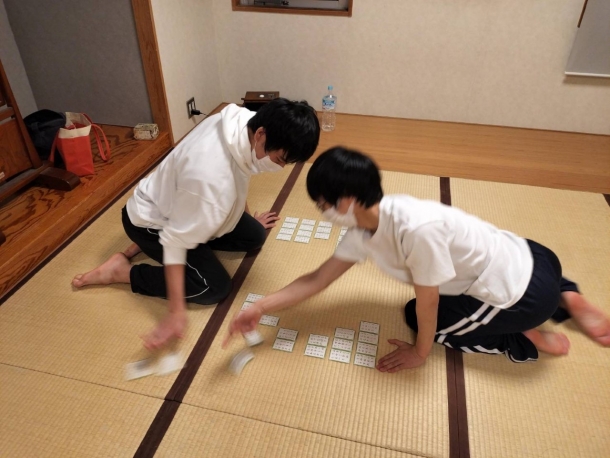
Practicing in the Japanese-style room of the Student Center. Karuta is also known as “martial arts on tatami mats.” In addition to memorizing poems, various abilities such as explosive action and memorization of card positions are required.
――What is the appeal of competitive karuta?
Koitabashi: It’s the exhilaration of snatching cards and the fun of sharpening your concentration. There are also poems in Hyakunin Isshu that were read more than a thousand years ago, and there are many songs about love. Even though the times are different, you can sympathize with their thoughts, and it is also interesting to familiarize yourself with the classics.
Tamiya: The elements of the match change each time depending on the cards and the opponent, so unlike Shogi and Go, it is difficult to research, and the patterns of standard tactics are not fixed, so this depth is also attractive.
――Please show us your clubroom “treasures.”
Tamiya: The most important thing we have is the cards. When multiple groups play next to each other, the group names are written on all the cards to avoid losing track of which groups the cards flying around belong to. The names are up to the club members.

Each set of cards has a name. The corners of the card become rounded as the years go by.
Koitabashi: The reading machine “Ariake” is indispensable for practice. It is a machine that randomly plays readings by dedicated readers (readers who are qualified to read, certified by the All Japan Karuta Association). Moreover, on the shelves of the clubroom, there are many trophies from team championships and championship in different classes. Incidentally, in the “27th University Student Karuta Championship” team competition (sponsored by the All Japan University Karuta Federation) held in 2022, we were runners-up.
Left: Ariake, a dedicated machine for reading Hyakunin Isshu, said to be useful for practice.
Right: A number of post trophies lined up.
【Information】
◆Club name: Waseda Karuta
◆Category: Student Club
◆Club established: 1957
◆Genre: Culture
◆Dates and times: Tuesday, Thursday, Friday, Saturday
◆Number of members: About 50
◆Locations: Tuesday Okubo Community Center, Shinjuku Ward;
Thursday and Saturday Japanese-style room, Student Center;
Friday Otsuka Community Activity Center, Bunkyo Ward
◆Twitter: @KarutaWaseda
4. Waseda University Latin America Association
Get into a rhythm that makes others want to join in. Livening up Waseda with Latin music. Waseda’s number one festival club
Ryosuke Yoshida, Secretary-General, 3rd year in the School of Political Science and Economics
Jeong Han-gyeol, Deputy Secretary-General, 3rd year in the School of Social Sciences
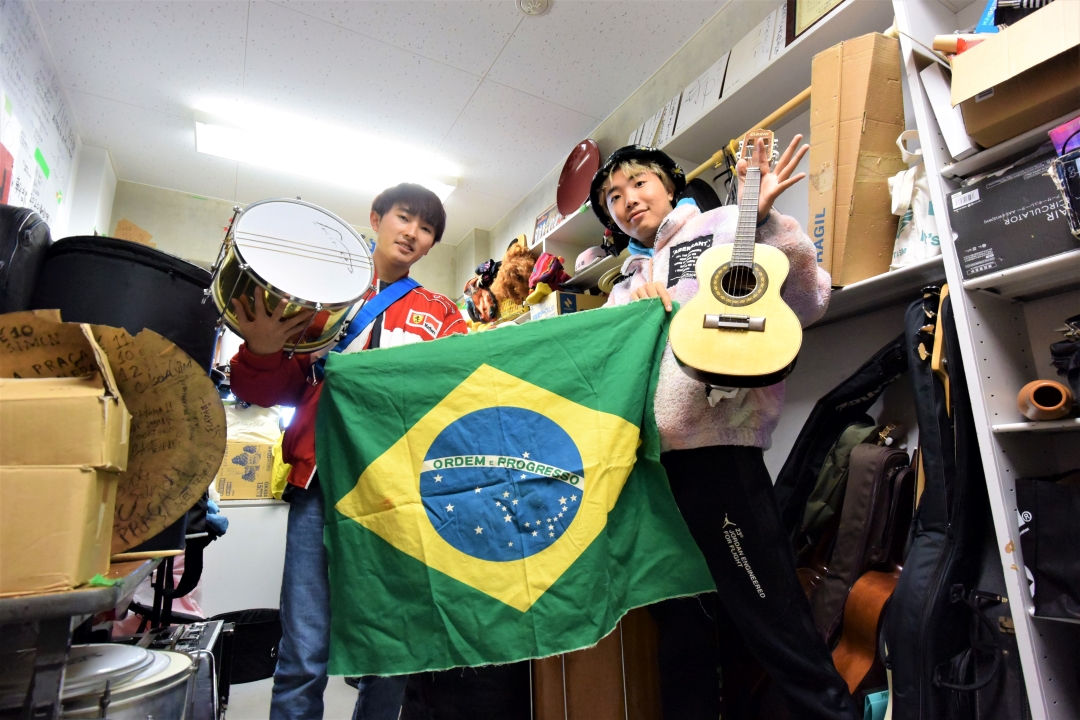
Yoshida-san (left) and Jeong-san (right) holding the Brazilian flag, the symbol of the Latin American Society.
――Please tell us about the activities of the club.
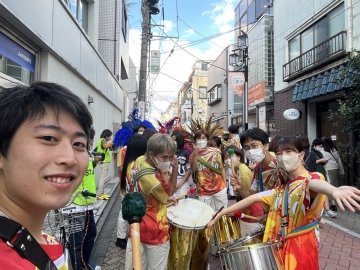
Photo taken when participating in the 16th Koenji Festival 2022.
Yoshida: The Waseda University Latin America Association practices twice a week, focusing on samba and other Latin music. Before the pandemic, we played Latin music on campus to liven up the newcomer welcoming activities. In addition, we have been invited to the Tomon Festival hosted by the Waseda University Alumni Association and festivals held by shopping districts around the country, where we sometimes liven up the place with Latin music.
Jeong: At the end of the year, we form a Latin genre band in the club and perform live. We’ll do anything related to Latin music! That’s the kind of club this is. Many of the members of the club are people who wanted to try new things at university or who joined after watching our videos. Since there are many beginners, our threshold as a music club is low, and one of the attractions is that everyone can enjoy playing together.
🔥早大の全サークルに告ぐ!🔥
おっすおっす🤩早大ラテンアメリカ協会だ🇧🇷
今年のラテアメは新歓ステージで例年のこんなやつを屋内でやろうと思ってるぞ😎😎そこで‼️‼️お立ち台に乗って一緒に盛り上がってくれるサークルを大大大募集🥳🥳🥳
出たいってサークルはDMしてきてくれよな📩待ってるぞ👊 pic.twitter.com/LftuoSwQNW
— 早大ラテンアメリカ協会 新歓2025 (@lateame_waseda) March 15, 2022
Welcoming new students with energy that draws in everyone close by.
――What kind of music is Latin music in the first place?
Jeong: It is music played using various types of instruments such as percussion instruments and string instruments, and it is characterized by a lively rhythm. The music at the Rio Carnival with the dancers dancing is representative of Latin music. However, in reality, Latin music is diverse, and a variety of styles are performed, from mellow tunes to pop and rock.
――How do you use the clubroom? Also, show us the unique treasures Latin America Association.
Yoshida: In addition to being used as a storage place for musical instruments, members gather in-between classes. Our treasures are, after all, our musical instruments. There are various types of percussion instruments, including the surdo, which is a large drum. With the variety of instruments we have, I think we’re in the top three among Waseda music clubs.
Left: Sampoña, a folk instrument from the Andean region of South America.
Right: Chocalho, surdo, agogo, and cavaquinho clockwise from the top right. The clubroom is crammed with various other instruments.
【Information】
◆Club name: Waseda University Latin America Association
◆Category: Student Club
◆Club established: 1950
◆Genre: Music
◆Dates and times: Monday, Thursday
◆Number of members: 40
◆Locations: Student Center
◆Website: https://wlaa.blogspot.com/
◆Twitter: @rateame
◆Instagram: @lateame_waseda
5. Waseda Society of Geography
It’s not just about walking around town. The diverse activities tailored to the interests of club members, such as trains, maps, and terrain, are the appeal.
Mina Imamura, Secretary-General, 3rd year in the School of Creative Science and Engineering
Yuta Yano, Deputy Secretary-General, 3rd year in the School of Education

Imamura-san holding a club magazine (left) and Yano-san holding the official mascot “Kumappu” of the Waseda Society of Geography (right).
――Please tell us about your activities and appeal of the club.
Yano: The mainstay of our activities is “Field Excursions”. This is a term used in geography, referring to so-called fieldwork where you visit various places according to certain themes to conduct surveys and research. Basically, we do this on weekends, mainly in the suburbs of Tokyo, and club members are welcome to participate. We do a variety of things, from activities around academic themes to casual “town walks.”
Imamura: We call it “Self Bura Tamori,” which is a play on words with the name of a famous Japanese TV program.
Left: Visit to the “Japanese origin of longitude and latitude,” which serves as the standard for Japan’s longitude and latitude during a Minato Ward inspection tour.
Right: Also on a Minato Ward inspection tour, members visited Zojoji Temple, which is located on the edge of the Musashino Plateau and has tombs of the Tokugawa shogunate family. They learned that Zojoji Temple is located higher than the low altitude at which the common people of the Edo period used to live, which served to demonstrate the authority of the shogunate family.
Imamura: In addition to the “subcommittee meetings” where people give presentations about their interests in the club, we also hold events, such as the “GeoSoc Hakone Ekiden” where we walk the Hakone Ekiden route.
Yano: At the Waseda Festival, we exhibit dioramas and distribute a club magazine summarizing members’ research. Recently, we have been focusing on disseminating information on social media, and in 2021, a quiz on the distribution of the convenience store Seicomart trended on Twitter.
突然ですが!これは何の分布を表したマップでしょうか❓️
ところで北海道ってすごく大きいんですね🏪#北海道 #茨城 #埼玉 pic.twitter.com/iEwrFYrwaw— 早稲田大学地理学研究会 (@geo_waseda) September 12, 2021
Based on the addresses of the store, we created a map using Geographic Information System (GIS).
――How do you use the clubroom?
Yano: On our open days, there are some members there, and there are books on maps and geography that you can use freely. Some members work on class assignments or chat.
Imamura: Some people play the game “Momotaro Dentetsu” (Nintendo Switch) where you can learn geography while playing. Also, many people go on trips during long vacations, and after the holidays, we have a lot of souvenirs from all over the country that everyone bought. That’s a typical sight at the Society of Geography!
――Please show us your clubroom “treasures.”
Yano: Perhaps the “Maps Commemorating the 4th Anniversary of the Emperor’s Enthronement.” It is a set of a special specification 10,000:1 topographic maps of Central Tokyo published by the Geospatial Information Authority of Japan to commemorate the enthronement of His Majesty the Emperor in the first year of Reiwa, and reprints of the Taisho, Showa, and Heisei enthronement commemorative maps, of which a limited number of 1,000 sets were sold. It is wrapped in furoshiki (wrapping cloth) and stored carefully.
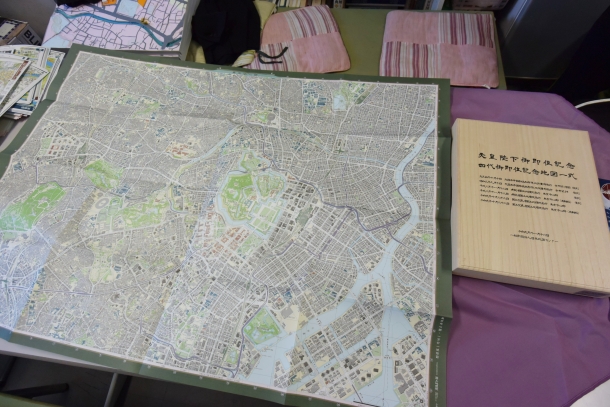
From “Maps Commemorating the 4th Anniversary of the Emperor’s Enthronement,” the 10,000:1 topographic maps of Central Tokyo published in the first year of Reiwa
Imamura: The old geography textbooks purchased at used bookstores are also valuable materials. Another treasure is the diorama of the university area that we created for the Waseda Festival 2021.
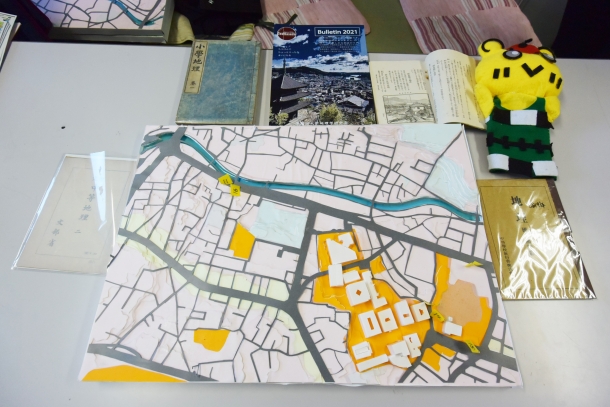
A diorama of the university area created by the members working together. Lined up around are old geography textbooks and club magazines, and the stuffed animals “Kumappu” said to have been inspired by pictures drawn by members around 2018.
【Information】
◆Club name: Waseda Society of Geography
◆Category: Student Club
◆Club established: 1950
◆Genre: History
◆Dates and times: Tuesday, Thursday, Friday (clubroom opening day, day of the week designated clubroom), Irregular (Field Excursions, various events)
◆Number of members: 147
◆Locations: Student Center, all over Japan (mainly in the Kanto suburbs)
◆Website: https://geowaseda1950.localinfo.jp/
◆Twitter: @geo_waseda
◆Instagram: @geo.waseda
Interviews, text, photos: Waseda Weekly reporters (SJC Student Staff)
Takumi Hasegawa, 4th year in the School of Education
Hiroto Yamamoto, 4th year in the School of Political Science and Economics
*This article is a translation from the Japanese edition of Waseda Weekly published on November 28, 2022. The content is current at the time of Japanese publication.

